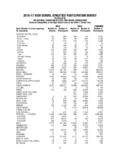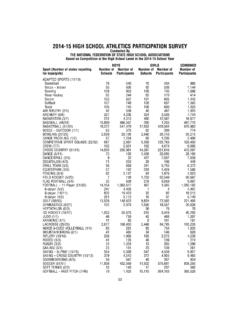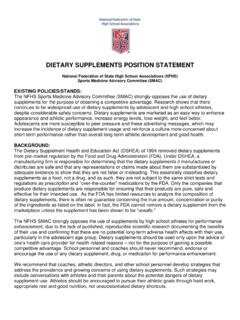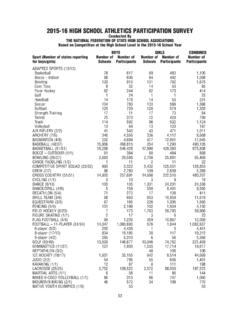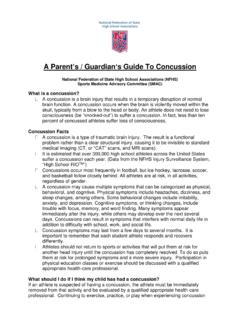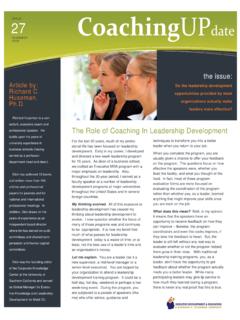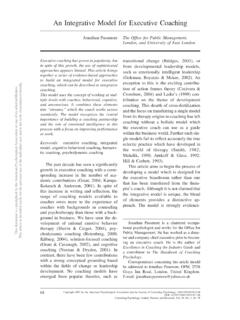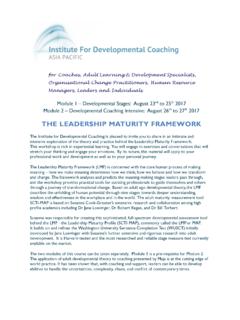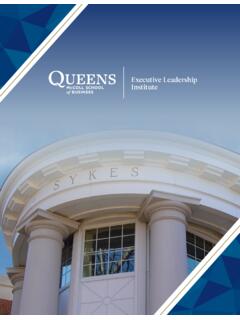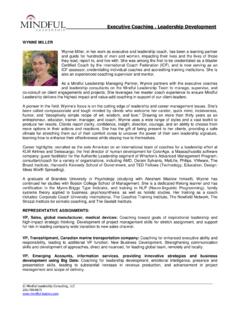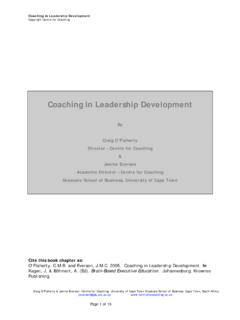Transcription of Coaching Leadership - NFHS
1 Coaching Leadership NIAAA Conference 2012. Philip J. Willenbrock, Ed. D. Dr. Philip J. Willenbrock 253-223-2850. Framework Why Coach Leadership Definitions Perspective ( & Coach Levels). Function and Structure Shared Leadership How To Coach Leadership HIB Impact Assessing Your Programs (Teams & Coaches). Dr. Philip J. Willenbrock 253-223-2850. Why Coach Leadership ? Necessity- HIB Issues Headlines - Media / Admin. Community Responsibility Youth Sport/ Outcomes ASB vs. Leadership Education Personnel/ Staffing Scheme / Strategy Team Leadership / Captains Dr. Philip J. Willenbrock 253-223-2850. Learning Journey High School College Professional 1990 2001.
2 2002 2003. 2004 2007. 2006 2009. 2010 - 2012. Dr. Philip J. Willenbrock 253-223-2850. Leadership (Defnintion/ function)). The process of persuasion or example by which an individual (or team) Induces a group to pursue objectives held by the Leader or Shared by the Leader and his/ her followers (Gardiner 1990). Model the way (align actions). Inspire a shared vision (envision, enlist). Challenge the process (innovate). Enable others to act (share power). Encourage the heart (recognize, celebrate). Dr. Philip J. Willenbrock 253-223-2850. Leadership (function). Leadership is a subtle process of Mutual INFLUENCE.
3 To produce a cooperative effort in the services of purposes and values embraced by both the leader and the led (Bolman & Deal 2003). (Basis for Team Analysis). Dr. Philip J. Willenbrock 253-223-2850. Team Leadership (function). A set of two or more people with complimentary skills who interact dynamically, interdependently and adaptively toward a common and valued goal/ objective/ mission who have been assigned specific roles to perform and who have a limited life-span of membership Dr. Philip J. Willenbrock 253-223-2850. Team Leadership (function). I. Creating Mental Model Objectives, constraints, roles, resources II.
4 Monitor internal and external environment Coordinate member behavior and interactions Skill development III. Establish behavior and perf. expectations Interaction patterns Team climate Dr. Philip J. Willenbrock 253-223-2850. Job of a Coach/ (function). Complexity How Do We Define Success? Create the environment for team effectiveness (Hackman, 2002). I. Create a Real Team (task, boundaries, authority, stability). II. Create a Compelling Direction (energize, orient, engage). III. Structure (Norms How and What). IV. Support Systems (Education, Reward). V. Expert Coaching (Effort, Strategy, Culture).
5 AP= PP PL+PG. Dr. Philip J. Willenbrock 253-223-2850. Complexity of Leadership TEAM. Leadership . PEERS/ COACH. TEAM. Leadership . Dr. Philip J. Willenbrock 253-223-2850. What Research Says About Why . Coaches have acknowledged that the team may lack motivation and cohesion if peer leaders do not emerge (Glenn & Horn, 1993). Glenn and Horn (1993) found that most coaches fail to consider psychological characteristics when assessing an athlete's Leadership abilities but rather choose players on athletic ability alone. (4 P's) position/ popularity / performance/ personality Coaches consider Leadership behavior among student athletes (peers) to be an important component of athletic success (Glenn & Horn, 1993).
6 Dr. Philip J. Willenbrock 253-223-2850. By arbitrarily choosing the number of athletes as team leaders, the likelihood that some athletes may be misclassified is increased those athletes who should be considered team leaders are not, and those athletes who are may not have the consensus of their teammates to truly be considered a team leader. (Loughead et al., 2005, p. 146). With regard to the captain selection process, appointment or election of team leaders does not ensure that the individuals designated to lead will do so effectively (Glenn & Horn). Dr. Philip J. Willenbrock 253-223-2850. Function / Structure New Paradigm Vertical vs.
7 Lateral inclusive of Peer Leadership Function of Coaching / Team Leadership Reveals Necessary Structures to Support Functions & Coaching Leaders Dr. Philip J. Willenbrock 253-223-2850. (Transformational Thought ). Thesis The Need For Leadership development - Cohesion - Culture of Citizenship (HIB). - Buy-In - Responsibility as a Profession Needs An Effective Structure Social Network Approach Dr. Philip J. Willenbrock 253-223-2850. Social Network = TEAM. Density & Centralization 50 Member Team Dr. Philip J. Willenbrock 253-223-2850. Density= # of Links Relative to Possible #. Nodes (members). Links (connections).
8 Dr. Philip J. Willenbrock 253-223-2850. Nodes Highly Dense 7 Member Team Links 7 Members = 21 Possible Links 20 Members = 190 Possible Links Dr. Philip J. Willenbrock 253-223-2850. 50 Member Team 1,225 Possible Links Dr. Philip J. Willenbrock 253-223-2850. Centralization Degree to Which Members are Unequally Central in The Network Highly Centralized Dr. Philip J. Willenbrock 253-223-2850. De- Centralized Structure Dr. Philip J. Willenbrock 253-223-2850. Basis for Shared Leadership Social Network suggests the degree of shared Leadership as (a) Leadership density The number of links (relationships) in a team relative to total possible links (b) Team centralization The degree to which members are unequally central in a team Teams exhibiting high density (many) with high de-centralization (wide-spread) represent the highest possible degree of shared Leadership Dr.
9 Philip J. Willenbrock 253-223-2850. (Transformational Thought). How to Coach Leadership ? - Shared Leadership System - Intentional Instruction Plan Controls - Team Assessment (Density and Centralization). - Coach Assessment (Rubric). Dr. Philip J. Willenbrock 253-223-2850. Network Centrality (INFLUENCE). Shared Leadership =. High Density & High De-Centralization Dr. Philip J. Willenbrock 253-223-2850. Traditional Model Low # of Links & Centralized Dr. Philip J. Willenbrock 253-223-2850. Shared Model High # of Links & Decentralized COACH (21). 21 21 21 21 21 21 21. Dr. Philip J. Willenbrock 253-223-2850.
10 8 SETS OF 7 (21 LINKS). Dr. Philip J. Willenbrock 253-223-2850. Teaching & Expecting Leadership Cultivating Leaders Shared Leadership . from a Leadership standpoint, the different functions served by coach and peer leaders provides some preliminary support for the suggestion that coaches should encourage the development of athlete (peer) Leadership within their respective teams to achieve optimal group performance . (Loughead and Hardy, 2005 p. 311). Dr. Philip J. Willenbrock 253-223-2850. What Shared Leadership Means Spread the wealth of Leadership by enabling multiple team members to step up and lead.
